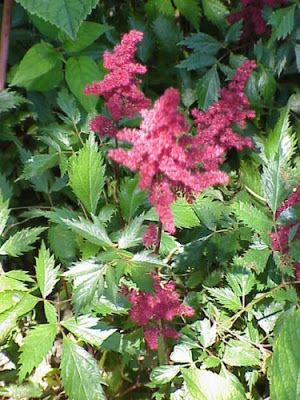Many of the Astilbes found in the British Isles today are hybrids. That is to say that they are a cross between two or more of the original wild species brought here by plant collectors from across the Far East where they are native.
Astilbes were first introduced in the UK in the 1800's largely from Japan and Korea where the species were predominantly white. In 1842 the Treaty of Nanking was signed to bring an end to the first opium war between Britain and the Qing Dynasty, which then opened up China to British plant collectors and travellers and it is then that pink species found there were introduced here. Possibly by Robert Fortune a famous plant hunter who was sent to China around that time by the Royal Horticultural Society. Most notable in the development of the Astilbe cultivars we find in our gardens today however, was probably a German nurseryman called Georg Arends (arendsii cultivars) who began crossing those early species in the 1900's. and is probably responsible for over seventy varieties. There are today Astilbes from pure white,shades of pink to deep red and mauve.
Perennials, Astilbes do best when planted in humus rich, moist boggy situations. Around ponds are ideal. They prefer light to partial shade but will tolerate full sun if kept well watered. They are kept at there best by giving them a feed with a compound fertilizer in the spring.
Astilbes are very low maintenance. There are not any real pest or disease problems affecting Astilbes so if yours are looking a little sad, start with a moisture check, and then giving them a feed should perk them up in most cases. Flowering takes place from late spring through the summer months, the feathery blooms still looking good after they have died and dried. Old or unwanted broken stalks can be cut and tidyed in late winter ready for the new spring growth. After a few years you should lift and split and replant your Astilbes to restore vigorous growth. This is best done in Autumn.
Pictures: top/bottom Narrowboat on The Kennet and Avon Canal, in Hungerford Berkshire. Opened in the 1700's it was used by canal narrow barges as a transport link from Bristol to the Thames in Reading. to find out more visit the Kennet and Avon Canal trusts website: here
General discussion and your views are welcome please say hello. I regret however because of my busy schedule, I am unable to answer many questions. Sneaky advertising will be deleted sorry. Thanks so much for visiting my blog today.








8 comments:
Hello,
I look forward to your posts. I dont blog as often as I did or should. I love to see your flowers.
Our climate is similar, and we share many varieties. Our winters are a bit more harsh, and summer much warmer but the plants get on. Thank you. :)
Hello Claudia, Thanks so much for your comment. Interesting that we have many plant varieties in common. Hope you manage to stay warm this winter. Simon
Hello, I haven't seen any posts lately. Thought I would let you know that I would enjoy any writeups you might offer. As a fellow gardener, I grow english roses, though hard at times. Look forward to seeing if you might offer any insight into growing from your part of the world.
Great post! It's really a nice flower you post. Thanks you for your very informative blog!
Great post! It's really a nice flower you post. Thanks you for your very informative blog!
Thanks for sharing with us.
Garden centre Merseyside
I am totally agree with all of your ideas..
Thank you for post..
Nice flower blog.
BEAUTIFUL! The photos is ♥
Post a Comment